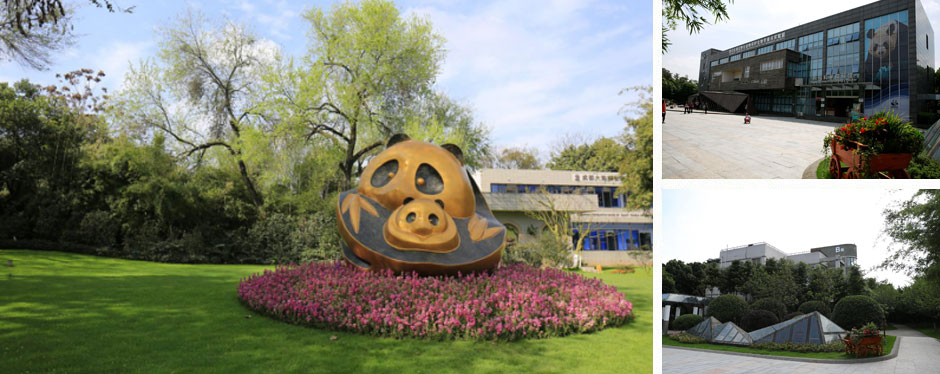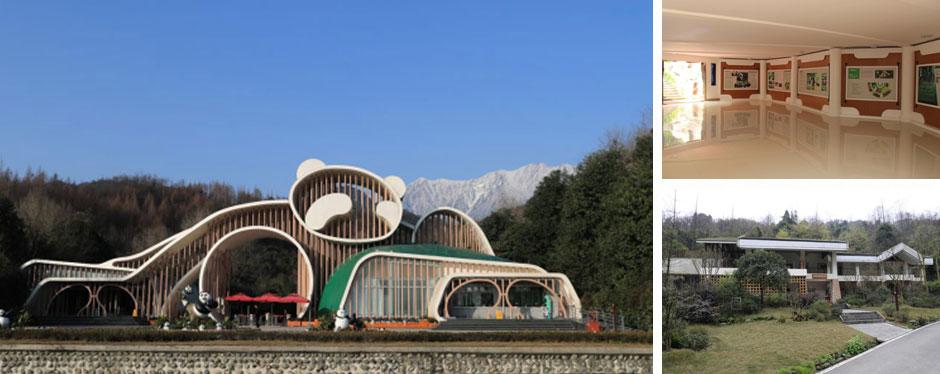The Chengdu Research Base of Giant Panda Breeding (hereinafter referred to as the Panda Base), located at 1375# Panda Road, Chenghua District, Chengdu City, Sichuan Province, P.R. China, is 10 km away from the city center (Tianfu Square) and about 30 km from Chengdu Shuangliu International Airport and about 50 km from Tianfu International Airport. Proclaimed the ecological demonstration project for giant panda ex-situ conservation, the Panda Base, covering an area of 3.07 square kilometers (once the new area is completely built), serves as the world’s preeminent institution for giant panda ex-situ conservation, scientific research and breeding, popular science education, and cultural tourism. The Panda Base wears its title as the sanctuary for giant pandas, red pandas, and other endangered wild animals exclusive to China with pride. The scenery is breathtaking: trees cover the slopes as crystal clear rivers wind down the hills. Forests line the paths, nesting birds that sing their sweet melodies. The Panda Base, as a beautiful garden, is China’s worst-kept secret –“the natural paradise of the national treasure and our Xanadu”.

I. Giant panda breeding
Over the past three decades, the Panda Base, thanks to its innovative research, has addressed key technical problems in feeding and management, reproduction and cub rearing, disease prevention and control, and population genetic management of giant pandas and established the largest ex-situ conserved population of captive giant pandas in the world, which now sits at over 230. In addition, the Panda Base has over 160 red pandas, also the world’s largest population of captive red pandas.

II. Giant panda research
Over the past three decades, the Panda Base, thanks to its innovative research, has successively addressed key technical problems in feeding and management, reproduction and cub rearing, disease prevention and control, and population genetic management of captive giant pandas, broken through a raft of technical bottlenecks, and constituted many original scientific research achievements. No other institute at home or abroad can rival the Panda Base’s capabilities in scientific research, technological achievements, and application and promotion of giant panda ex-situ conservation. The Panda Base won the honor National Advanced Collective of Technical Talent in 2014 jointly awarded by the Organization Department of the Central Committee of the CPC, the Publicity Department of the Central Committee of the CPC, the Ministry of Human Resources and Social Security of the P.R.C., and the Ministry of Science and Technology of the P.R.C.

III.Giant panda conservation education
At the turn of the millennium, the Panda Base was the first in the national wildlife conservation system to establish the Department of Popular Science Education. In 2021, it established and operated the world’s first giant panda museum which has adopted interactive experiences. Over the last decade, the Panda Base has held or co-held all manner of science popularization education, exceeding 3,000 events. The Panda Base has been awarded the accolades, such as the National Popular Science Education Base, National Youth Science and Technology Education Base, National Base for Popular Science of Ecological Environment, Base for Popular Science Education on Studying Makes a Country Strong, National Green Camp for Youth Nature Education, Cross-Strait Exchange Base, and more. In 2020, the Panda Base was rated as the National Advanced Collective of Science Popularization by the Ministry of Science and Technology, Publicity Department of the Central Committee of the CPC, and China Association for Science and Technology.
IV. Giant panda tourism
The Panda Base, adhering to the guiding principle that places an equal emphasis on scientific research and tourism, has created a sustainable development model for production, study, research, and tourism. The Panda Base simulated the ecological environment of the giant pandas in the wild by creating a garden, with the delivery house, feeding area, research laboratory, and panda hospital in orderly distribution. Several luxury panda “villas” are tucked into the mountains and forests. Giant pandas of different ages grow up and thrive here, and the matured and young live together in harmony and enjoy themselves well. The Panda Base won the Global 500 Roll of Honour for Environmental Achievement, the UN’s highest environmental award, twice. It was accredited as a national AAAA tourist attraction in 2006. It has received many UN dignitaries and state heads, and ten thousand distinguished guests. It even once received over 9 million visitors in one year.
V. Chengdu Field Research Center for Giant Pandas — Panda Valley
Set in Majiagou, Yutang Town, Dujiangyan City, the Chengdu Research Base of Giant Panda Breeding Dujiangyan Field Research Center for Giant Pandas — Panda Valley, covering an area of 2,004 mu (133.6 hectares), is adjacent to the ancient Dujiangyan Irrigation Project and Mt. Qingcheng, a sacred Taoist place. It is also 50 km from Chengdu and 3 km or so from Dujiangyan proper. It is easily accessible from the Chengdu-Dujiangyan Expressway, light rail, and the mountain-encircling road that connects Mt. Zhaogong and Mt. Qingcheng. The countless bamboo and trees afford glorious shade and lend the place a very leafy complexion, spotted with gurgling streams, singing birds, and fragrant flowers. This land of plenty, blessed with a unique natural climate, is home to over 700 species of flora and fauna and a natural base for reintroducing giant pandas. Panda Valley was officially opened to the public on April 20, 2015. More than 10 giant pandas are living here year round.

SOURCE:http://www.panda.org.cn/english/about/about/2013-09-11/2416.html
